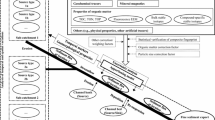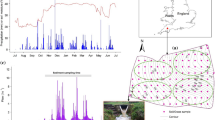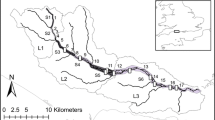Abstract
Purpose
Catchments subject to land clearance, soil tillage and grazing suffer legacy effects from altered sediment and hydrological regimes and from changes in sediment connectivity between hillslopes and channels. Sediment dynamics are routinely investigated using the fallout radionuclides (FRNs) caesium-137 (137Cs) and excess lead-210 (210Pbex), which provide information regarding sediment sources and fluvial processes if source types are differentiated with confidence. Downstream transport, mixing and dilution of FRN-labelled fine sediment can obliterate the tracer signal from sources with low initial concentrations, so geomorphic evidence for downstream changes in sediment source types, mixing and fluvial (dis)connectivity should be used with tracers to ascertain the degree of sediment source variation and dominant fluvial processes.
Materials and methods
We coupled sediment source tracing with a geomorphic assessment of downstream hydrological, morphological and sedimentological change to quantify key components of fluvial (dis)connectivity in Coolbaggie Creek, a major source of sediment to the Macquarie River, southeastern Australia.
Results and discussion
Cs and 210Pbex discriminated between the <63-μm fraction of topsoils from agricultural and forested land (mean ± standard error of 137Cs is 5.7 ± 1.1 Bq kg−1 and of 210Pbex is 76.2 ± 22.4 Bq kg−1) and subsoils from channel banks and gullies (137Cs = 1.5 ± 0.5 Bq kg−1; 210Pbex = 3.6 ± 2.4 Bq kg−1). In-channel sediment was a mix of these two source types (137Cs = 0.9 ± 0.3 Bq kg−1; 210Pbex = 18.8 ± 6.8 Bq kg−1). FRN concentrations also declined significantly downstream. Mixing model results show topsoils account for 39 % (95 % confidence interval (CI) = 21–88 %) of fine in-channel sediment in the upper reaches, but this declines to 2 % (CI = 0–19 %) after 25 km, and thereafter, subsoils account for an estimated 100 % of fine sediment in the system. This rapid decrease in topsoil contributions coincides with a downstream change in hydrogeomorphic character, including large increases in channel cross-sectional area (∼20 to >200 m2) and unit stream power (5.4 to 1,382 W m−2), and evidence of greater subsoil and reworked sediment contributions from bank and gully erosion. Limited topsoil supply to the trunk stream suggests low catchment erosion rates and reduced connectivity between the catchment and the river. Enlargement and entrenchment of the trunk stream in the lower reaches have resulted in lateral channel–floodplain disconnection, while a sediment slug impedes longitudinal coarse sediment transfer.
Conclusions
Hydrogeomorphic change and sediment source variations downstream explain the short-term sediment dynamics in this agricultural catchment, which has broader implications for understanding sediment transport processes and fluvial (dis)connectivity when interpreting sediment source and tracer data.








Similar content being viewed by others
References
Belmont P, Willenbring JK, Schottler SP, Marquard J, Kumarasamy K, Hemmis JM (2014) Toward generalizable sediment fingerprinting with tracers that are conservative and nonconservative over sediment routing timescales. J Soils Sediments 14:1479–1492
Blumentritt DJ (2013) Reconstructing the erosional history of the Upper Mississippi River from magnetic, isotopic, and geomorphic evidence. Unpublished PhD dissertation, University of Minnesota, USA
BOM (2012) Australian Government Bureau of Meteorology. Climate statistics for Australian locations: Gilgandra, Australia. http://www.bom.gov.au/climate/averages/tables/cw_051018.shtml Accessed 15 August 2012
Brierley G, Fryirs K (2005) Geomorphology and river management: applications of the river styles framework. Blackwell Publishing, Victoria
Collins AL, Walling DE, Leeks GJL (1997) Source type ascription for fluvial suspended sediment based on a quantitative composite fingerprinting technique. Catena 29:1–27
Croke J, Fryirs K, Thompson C (2013) Channel-floodplain connectivity during an extreme flood event: implications for sediment erosion, deposition and delivery. Earth Surf Process Landf 38:1444–1456
CSIRO (2008a) Water availability in the Murray-Darling basin. A report to the Australian Government from the CSIRO Murray-Darling Basin Sustainable Yields Project. CSIRO, Canberra, 67 pp
CSIRO (2008b) Water availability in the Macquarie-Castlereagh. A report to the Australian Government from the CSIRO Murray-Darling Basin Sustainable Yields Project. CSIRO, Canberra, 144 pp
Davies-Colley RJ, Smith DG (2001) Turbidity, suspended sediment, and water clarity: a review. J Am Water Resour Assoc 35:1085–1101
Davies-Colley RJ, Hickey CW, Quinn JM, Ryan PA (1992) Effects of clay discharge on streams: optical properties and epilithon. Hydrobiologia 248:215–234
Fryirs KA (2013) (Dis)connectivity in catchment sediment cascades: a fresh look at the sediment delivery problem. Earth Surf Process Landf 38:30–46
Fryirs KA, Brierley GJ (2013) Geomorphic analysis of river systems: an approach to reading the landscape. Wiley, Chichester, 345 pp
Fryirs K, Gore D (2013) Sediment tracing in the upper Hunter catchment using elemental and mineralogical composition: implications for catchment-scale suspended sediment (dis)connectivity and management. Geomorphology 193:128–142
Fryirs KA, Brierley GJ, Preston NJ, Kasai M (2007a) Buffers, barriers and blankets: the (dis)connectivity of catchment scale sediment cascades. Catena 70:49–67
Fryirs KA, Brierley GJ, Preston NJ, Spencer J (2007b) Catchment-scale (dis)connectivity in sediment flux in the upper Hunter catchment, New South Wales, Australia. Geomorphology 84:296–316
Green D, Petrovic J, Moss P, Burrell M (2011) Water resources and management overview: Macquarie-Bogan catchment. NSW Office of Water, Sydney
Hancock GJ, Wilkinson SN, Hawdon AA, Keen RJ (2014) Use of fallout tracers 7Be, 210Pb and 137Cs to distinguish the form of sub-surface soil erosion delivering sediment to rivers in large catchments. Hydrol Process 28:3855–3874
Harvey AM (2001) Coupling between hillslopes and channels in upland fluvial systems: implications for landscape sensitivity illustrated from the Howgill Fells, northwest England. Catena 42:225–250
Harvey AM (2002) Effective timescales of coupling within fluvial systems. Geomorphology 44:175–201
Henley WF, Patterson MA, Neves RJ, Lemly AD (2000) Effects of sedimentation and turbidity on lotic food webs: a concise review for natural resource managers. Rev Fish Sci 8:125–139
Hooke J (2003) Coarse sediment connectivity in river channel systems: a conceptual framework and methodology. Geomorphology 58:79–94
Hughes AO, Olley JM, Croke JC, McKergow LA (2009) Sediment source changes over the last 250 years in a dry-tropical catchment, central Queensland, Australia. Geomorphology 104:262–275
Isbell RF (2002) The Australian soil classification (revised edition). CSIRO Publishing, Collingwood
Kobayashi T, Ryder DS, Ralph TJ, Kelleway J, Mazumder D, Saintilan N, Iles J, Knowles L, Thomas R, Hunter S (2011) Longitudinal spatial variation in ecological conditions in an in-channel floodplain river system during flow pulses. River Res Appl 27:461–472
Koiter AJ, Lobb DA, Owens PN, Petticrew EL, Tiessen KHD, Li S (2013a) Investigating the role of connectivity and scale in assessing the sources of sediment in an agricultural watershed in the Canadian prairies using sediment source fingerprinting. J Soils Sediments 13:1676–1691
Koiter AJ, Owens PN, Petticrew EL, Lobb DA (2013b) The behavioural characteristics of sediment properties and their implications for sediment fingerprinting as an approach for identifying sediment sources in river basins. Earth-Sci Rev 125:24–42
Laceby JP, Olley J (2015) An examination of geochemical modelling approaches to tracing sediment sources incorporating distribution mixing and element concentrations. Hydrol Process 29:1669–1685
Metcalfe L, Sivertsen DP, Tindall D, Ryan KM (2003) Natural vegetation of the New South Wales wheat-belt (Cobar-Nyngan-Gilgandra, Nymagee-Narromine-Dubbo 1:250 000 vegetation sheets). Cunninghamia 8:253–284
Motha JA, Wallbrink PJ, Hairsine PB, Grayson RB (2002) Tracer properties of eroded sediment and source material. Hydrol Process 16:1983–2000
NOW (2012) New South Wales water info, real time data, rivers and streams. New South Wales Office of Water, Department of Primary Industries, Sydney, Australia. http://realtimedata.water.nsw.gov.au/water.stm Accessed 19 July 2012
Olive LJ, Rieger WA (1986) Low Australian sediment yields: a question of inefficient sediment delivery. In: Hadley RF (ed) Drainage basin sediment delivery. IAHS Publ 159, IAHS Press, Wallingford, pp 305–322
Olive LJ, Olley JM, Wallbrink PJ, Murray AS (1996) Downstream patterns of sediment transport during floods in the Murrumbidgee River, NSW Australia. Zeitschrift für Geomorphologie Suppl-Bd 105:129–140
Olley JM, Scott A (2002) Sediment supply and transport in the Murrumbidgee and Namoi Rivers since European settlement. Technical report 9/02. CSIRO Land and Water, Canberra
Olley JM, Wasson RJ (2003) Changes in the flux of sediment in the Upper Murrumbidgee catchment, southeastern Australia, since European settlement. Hydrol Process 17:3307–3320
Owens PN, Batalla RJ, Collins AJ, Gomez B, Hicks DM, Horowitz AJ, Kondolf GM, Marden M, Page MJ, Peacock DH, Petticrew EL, Salomons W, Trustrum NA (2005) Fine-grained sediment in river systems: environmental significance and management issues. River Res Appl 21:693–717
Owens PN, Blake WH, Giles TR, Williams ND (2012) Determining the effects of wildfire on sediment sources using 137Cs and unsupported 210Pb: the role of landscape disturbances and driving forces. J Soils Sediments 12:982–999
Palmer MA, Covich AP, Lake S, Biro P, Brooks JJ, Cole J, Dahm J, Gibert J, Giedkoop W, Martens K, Verhoeven J, Van De Bund WJ (2000) Linkages between aquatic sediment biota and life above sediments as potential drivers of biodiversity and ecological processes. Bioscience 50:1062–1075
Prosser IP, Rutherfurd ID, Olley JM, Young WJ, Wallbrink PJ, Moran CJ (2001) Large-scale patterns of erosion and sediment transport in river networks, with examples from Australia. Mar Freshw Res 52:81–99
Ralph TJ, Hesse PP (2010) Downstream hydrogeomorphic changes along the Macquarie River, southeastern Australia, leading to channel breakdown and floodplain wetlands. Geomorphology 118:48–64
Ralph TJ, Kobayashi T, García A, Hesse PP, Yonge D, Bleakley N, Ingleton T (2011) Paleoecological responses to avulsion and floodplain evolution in a semiarid Australian freshwater wetland. Aust J Earth Sci 58:75–91
Ralph TJ, Hesse PP, Kobayashi T (2015) Wandering wetlands: spatial patterns of historical channel and floodplain change in the Ramsar-listed Macquarie Marshes, Australia. Mar Freshw Res. doi:10.1071/MF14251
Small IF, Rowan JS, Franks SW (2002) Quantitative sediment fingerprinting using a Bayesian uncertainty estimation framework. In: Dyer FJ, Thoms MC, Olley JM (eds) The structure, function and management implications of fluvial sedimentary systems. IAHS 276, IAHS Press, Wallingford, pp 443–450
Smith HG (2008) Estimation of suspended sediment loads and delivery in an incised upland headwater catchment, south-eastern Australia. Hydrol Process 22:3135–3148
Smith HG, Blake WH (2014) Sediment fingerprinting in agricultural catchments: a critical re-examination of source discrimination and data corrections. Geomorphology 204:177–191
Smith HG, Dragovich D (2008) Improving precision in sediment source and erosion process distinction in an upland catchment, south-eastern Australia. Catena 72:191–203
Smith HG, Sheridan GJ, Lane PNJ, Noske PJ, Heijnis H (2011) Changes to sediment sources following wildfire in a forested upland catchment, southeastern Australia. Hydrol Process 25:2878–2889
Smith HG, Blake WH, Owens PN (2013) Discriminating fine sediment sources and the application of sediment tracers in burned catchments: a review. Hydrol Process 27:943–958
Stout JC, Belmont P, Schottler SP, Willenbring JK (2014) Identifying sediment sources and sinks in the Root River, Southeastern Minnesota. Ann Assoc Am Geogr 104:20–39
Tomkins KM, Hesse PP (2004) Evidence of Late Cenozoic uplift and climate change in the stratigraphy of the Macquarie River Valley, New South Wales. Aust J Earth Sci 51:273–290
Walden J, Slattery MC, Burt TP (1997) Use of mineral magnetic measurements to fingerprint suspended sediment sources: approaches and techniques for data analysis. J Hydrol 202:353–372
Wallbrink PJ, Murray AS (1993) Use of fallout radionuclides as indicators of erosion processes. Hydrol Process 7:297–304
Wallbrink P, Olley J (2004) Sources of fine grained sediment in incised and unincised channels, Jugiong Creek, NSW, Australia. In: Golosov V, Belyaev V, Walling DE (eds) Sediment transfer through fluvial systems. IAHS Publ 228, IAHS Press, Wallingford, pp 165–169
Wallbrink PJ, Olley JM, Murray AS (1996) The contribution of subsoil to sediment yields in the Murrumbidgee River basin, New South Wales, Australia. In: Walling DE, Webb BW (eds) Erosion and sediment yield: global and regional perspectives. IAHS Publ 236, IAHS Press, Wallingford, pp 347–255
Wallbrink PJ, Murray AS, Olley JM (1998) Determining sources and transit times of suspended sediment in the Murrumbidgee River, New South Wales, Australia, using fallout 137Cs and 210Pb. Water Resour Res 34:879–887
Walling DE (2003) Using environmental radionuclides as tracers in sediment budget investigations. In: Bogen J, Fergus T, Walling DE (eds) Erosion and sediment transport measurements in rivers: technological and methodological advances. IAHS Publ 283, IAHS Press, Wallingford, pp 57–78
Walling DE (2006) Human impact on land-ocean sediment transfer by the world’s rivers. Geomorphology 79:192–216
Walling DE (2013) The evolution of sediment source fingerprinting investigations in fluvial systems. J Soils Sediments 13:1658–1675
Wasson RJ, Olive LJ, Rosewell CJ (1996) Rates of erosion and sediment transport in Australia. In: Walling DE, Webb BW (eds) Erosion and sediment yield: global and regional perspectives. IAHS Publ 236, IAHS Press, Wallingford, pp 139–148
Wasson RJ, Mazart RK, Starr B, Clifton G (1998) The recent history of erosion and sedimentation on the Southern Tablelands of southeastern Australia: sediment flux dominated by channel incision. Geomorphology 24:291–308
Watkins JJ, Meakin NS (1996) Explanatory notes: Nyngan and Walgett 1:250,000 geological sheets SH/55-15 and SH/55-11. Geological survey of New South Wales. Sydney, Australia, 111 pp
Wilkinson SN, Hancock GJ, Bartley R, Hawdon AA, Keen RJ (2013) Using sediment tracing to assess processes and spatial patterns of erosion in grazed rangelands, Burdekin River basin, Australia. Agric Ecosyst Environ 180:90–102
Young RW, Young ARM, Price DM, Wray RAL (2002) Geomorphology of the Namoi alluvial plain, northwestern New South Wales. Aust J Earth Sci 49:509–523
Yu L, Oldfield F (1989) A multivariate mixing model for identifying sediment source from magneticmeasurements. Quat Res 22:168-181
Zapata F (2003) The use of environmental radionuclides as tracers in soil erosion and sedimentation investigations: recent advances and future developments. Soil Tillage Res 69:3–13
Acknowledgments
T.J.R., H.G.S. and A.S.W. acknowledge funding from a Science and Industry Endowment Fund (SIEF) Honours Scholarship (HS12-001) and an Australian Institute of Nuclear Science and Engineering (AINSE) award (ALNGRA12090). We also thank Atun Zawadzki and Daniela Fierro who provided valuable assistance with gamma spectrometry analysis at ANSTO and to Zacchary Larkin, Samantha Oyston and Marek Rouillon from Macquarie University for their support and assistance in the field and laboratory. We also thank two anonymous reviewers who provided constructive feedback on the manuscript.
Author information
Authors and Affiliations
Corresponding author
Additional information
Responsible editor: William H. Blake
Rights and permissions
About this article
Cite this article
Wethered, A.S., Ralph, T.J., Smith, H.G. et al. Quantifying fluvial (dis)connectivity in an agricultural catchment using a geomorphic approach and sediment source tracing. J Soils Sediments 15, 2052–2066 (2015). https://doi.org/10.1007/s11368-015-1202-7
Received:
Accepted:
Published:
Issue Date:
DOI: https://doi.org/10.1007/s11368-015-1202-7




